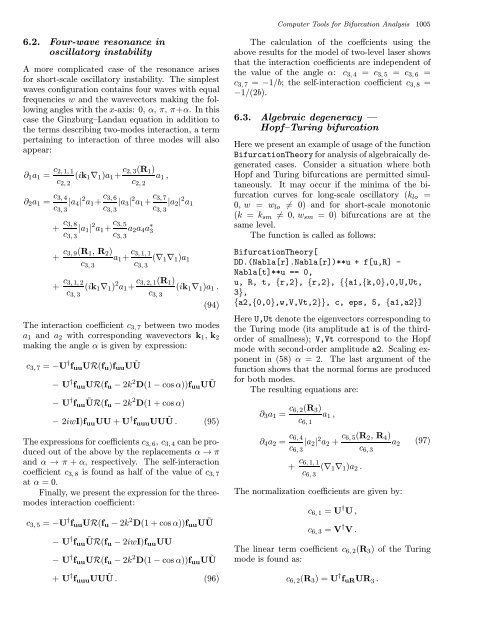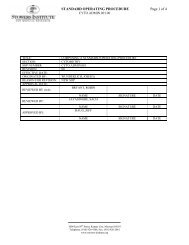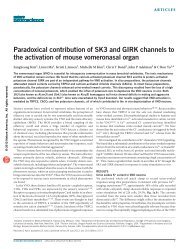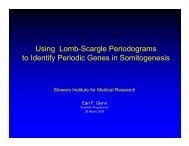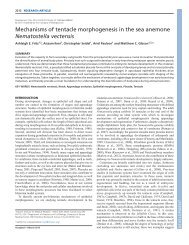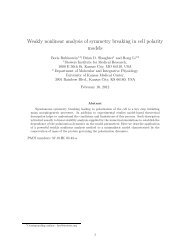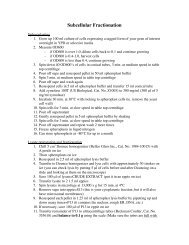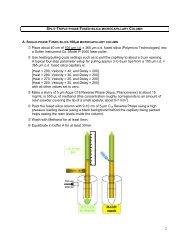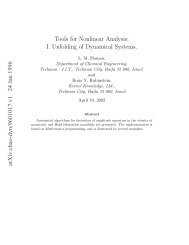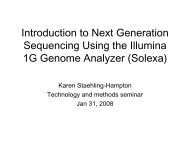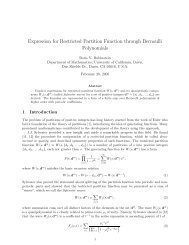Computer Tools for Bifurcation Analysis: General Approach with
Computer Tools for Bifurcation Analysis: General Approach with
Computer Tools for Bifurcation Analysis: General Approach with
Create successful ePaper yourself
Turn your PDF publications into a flip-book with our unique Google optimized e-Paper software.
<strong>Computer</strong> <strong>Tools</strong> <strong>for</strong> <strong>Bifurcation</strong> <strong>Analysis</strong> 1005<br />
The calculation of the coeffcients using the<br />
6.2. Four-wave resonance in<br />
+ U † f uuu UUŨ . (96) c 6, 2 (R 3 )=U † f uR UR 3 .<br />
oscillatory instability<br />
above results <strong>for</strong> the model of two-level laser shows<br />
that the interaction coefficients are independent of<br />
A more complicated case of the resonance arises the value of the angle α: c 3, 4 = c 3, 5 = c 3, 6 =<br />
<strong>for</strong> short-scale oscillatory instability. The simplest c 3, 7 = −1/b; the self-interaction coefficient c 3, 8 =<br />
waves configuration contains four waves <strong>with</strong> equal −1/(2b).<br />
frequencies w and the wavevectors making the following<br />
angles <strong>with</strong> the x-axis: 0, α,π,π+α.Inthis<br />
case the Ginzburg–Landau equation in addition to 6.3. Algebraic degeneracy —<br />
the terms describing two-modes interaction, a term Hopf–Turing bifurcation<br />
pertaining to interaction of three modes will also<br />
Here we present an example of usage of the function<br />
appear:<br />
<strong>Bifurcation</strong>Theory <strong>for</strong> analysis of algebraically degenerated<br />
cases. Consider a situation where both<br />
∂ 1 a 1 = c 2, 1, 1<br />
(ik 1 ∇ 1 )a 1 + c 2, 3(R 1 )<br />
a 1 ,<br />
Hopf and Turing bifurcations are permitted simultaneously.<br />
It may occur if the minima of the bi-<br />
c 2, 2 c 2, 2<br />
∂ 2 a 1 = c 3, 4<br />
|a 4 | 2 a 1 + c 3, 6<br />
|a 3 | 2 a 1 + c 3, 7<br />
|a 2 | 2 furcation curves <strong>for</strong> long-scale oscillatory (k lo =<br />
a 1<br />
c 3, 3 c 3, 3 c 3, 3<br />
0, w = w lo ≠ 0) and <strong>for</strong> short-scale monotonic<br />
(k = k sm ≠0,w sm = 0) bifurcations are at the<br />
+ c 3, 8<br />
|a 1 | 2 a 1 + c 3, 5<br />
a 2 a 4 a ∗ same level.<br />
3<br />
c 3, 3 c 3, 3 The function is called as follows:<br />
+ c 3, 9(R 1 , R 2 )<br />
a 1 + c 3, 1, 1<br />
<strong>Bifurcation</strong>Theory[<br />
(∇ 1 ∇ 1 )a 1<br />
c 3, 3 c 3, 3<br />
DD.(Nabla[r].Nabla[r])**u + f[u,R] -<br />
Nabla[t]**u == 0,<br />
+ c 3, 1, 2<br />
(ik 1 ∇ 1 ) 2 a 1 + c 3, 2, 1(R 1 )<br />
u, R, t, {r,2}, {r,2}, {{a1,{k,0},0,U,Ut,<br />
(ik 1 ∇ 1 )a 1 .<br />
c 3, 3 c 3, 3 3},<br />
(94) {a2,{0,0},w,V,Vt,2}}, c, eps, 5, {a1,a2}]<br />
Here U,Ut denote the eigenvectors corresponding to<br />
The interaction coefficient c 3, 7 between two modes<br />
the Turing mode (its amplitude a1 is of the thirdorder<br />
of smallness); V,Vt correspond to the Hopf<br />
a 1 and a 2 <strong>with</strong> corresponding wavevectors k 1 , k 2<br />
making the angle α is given by expression:<br />
mode <strong>with</strong> second-order amplitude a2. Scaling exponent<br />
c 3, 7 = −U † f uu UR(f u )f uu UŨ<br />
in (58) α = 2. The last argument of the<br />
function shows that the normal <strong>for</strong>ms are produced<br />
− U † f uu UR(f u − 2k 2 <strong>for</strong>bothmodes.<br />
D(1 − cos α))f uu UŨ<br />
The resulting equations are:<br />
− U † f uu ŨR(f u − 2k 2 D(1 + cos α)<br />
− 2iwI)f uu UU + U † f uuu UUŨ . (95)<br />
∂ 3 a 1 = c 6, 2(R 3 )<br />
a 1 ,<br />
c 6, 1<br />
The expressions <strong>for</strong> coefficients c 3, 6 ,c 3,4 can be produced<br />
out of the above by the replacements α → π<br />
∂ 4 a 2 = c 6, 4<br />
|a 2 | 2 a 2 + c 6, 5(R 2 , R 4 )<br />
a 2<br />
c 6, 3 c 6, 3<br />
(97)<br />
and α → π + α, respectively. The self-interaction<br />
coefficient c 3, 8 is found as half of the value of c 3, 7<br />
+ c 6, 1, 1<br />
(∇ 1 ∇ 1 )a 2 .<br />
c 6, 3<br />
at α =0.<br />
Finally, we present the expression <strong>for</strong> the threemodes<br />
The normalization coefficients are given by:<br />
interaction coefficient:<br />
c 6, 1 = U † U ,<br />
c 3, 5 = −U † f uu UR(f u − 2k 2 D(1 + cos α))f uu UŨ<br />
− U † f uu ŨR(f u − 2iwI)f uu UU<br />
− U † f uu UR(f u − 2k 2 D(1 − cos α))f uu UŨ<br />
c 6, 3 = V † V .<br />
The linear term coefficient c 6, 2 (R 3 ) of the Turing<br />
mode is found as:


